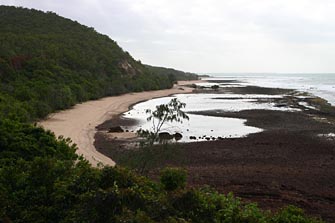Rebuilding Yambirrpa
A Galtha
workshop on the renewal of a stone fishtrap
 |
|
In Term 3, 2004, community educators at the school at Yirrkala decided to hold a Galtha workshop on the renewal of a traditional fishtrap, or Yambirrpa.
There were a number of motivations behind the idea of running a workshop on the construction of a traditional tidal fishtrap: it would follow on nicely from the focus unit on ‘gapu’ or ‘water’ that had been held earlier that year; one of the senior elders at Yirrkala had for some time wanted to organise the building of a traditional estuarine fishtrap in an effort to maintain knowledge of how this should be done; and the Principal at the school was keen to use the building of a fishtrap as a metaphor for health and welfare messages about healthy living and the importance of working together as a community. Thus it was appropriately framed as a Galtha workshop, where different people come to an event with different ideas about what is going to happen and then work out a solution between them.
There were quite a number of different players. Firstly there were the Rirratjiŋu clan elders, who are the senior landowners at Mirriki, where the fishtrap was to be renewed. Most senior among this group was Laŋani Marika, who remembered the building of the fishtrap from when she was a young girl. The second group of significance were the Djuŋgaya, or classificatory ‘sister’s children’ of the Rirratjiŋu who have the role of custodians or executors of Rirratjiŋu clan business, but who are also obliged to work for their mother’s clan. A third group were the Dhimurru (Land Management Aboriginal Corporation) Rangers who had been asked to facilitate the workshop by providing vehicles and a quad bike to transport some participants who would have had difficulty walking to the site. However there was some overlap between groups here, as most of the Dhimurru Rangers involved were also Rirratjiŋu clan members. Then there were the teachers, some of whom were also Rirratjiŋu, and finally, the students, although they did not appear to have any input into the form of the event.
This workshop did not attempt to incorporate a western science approach, although it would have been quite easy to do so: some discussion of tides, for example, would have fitted in well. Instead, the excursion concentrated on Indigenous understandings.
On the day of the excursion everyone gathered at Nuwul, a headland just to the north of Yirrkala. They then began the walk along several beaches and across another headland to the site of the fishtrap, where a large rock platform forms a natural rock pool where fish get caught at low tide.
After more instruction about this special place, everyone proceeded along the beach to throw rocks onto two ‘wishing’ or ‘turtle’ rocks that are manifestations of two ancestral turtle hunters, one Djambarrpuyŋu clan and the other Rirratjiŋu. The throwing of rocks to make a wish for a good catch is a reference to the ancestral story where the turtle hunters were asked by their families to share their catch. The Djambarrpuŋu hunter refused to share, and for this reason the Djambarrpuyŋu rock will not bring you luck in fishing, though making a wish at both rocks is still important.
 |
|
The men then began singing the song-cycle relating to the creation of a fishtrap in ancestral times as they processed back along the beach. The songs turned to the actual building of the Yambirrpa by the ancestral fisherman as they reached the Rirratjiŋu end of the rock platform. As these songs were sung everyone suddenly began building a rock wall across the middle of the rock pool. At the same time, some of the older boys went into the water and started spearing fish.
For a full description of this workshop and an interrogation of the ‘Indigenous science’ evident in it, see Deveson, (2005).
